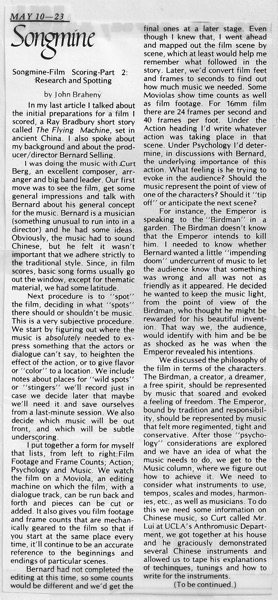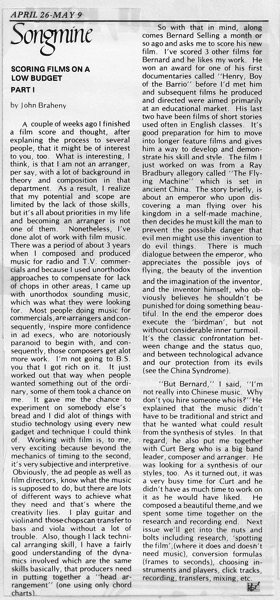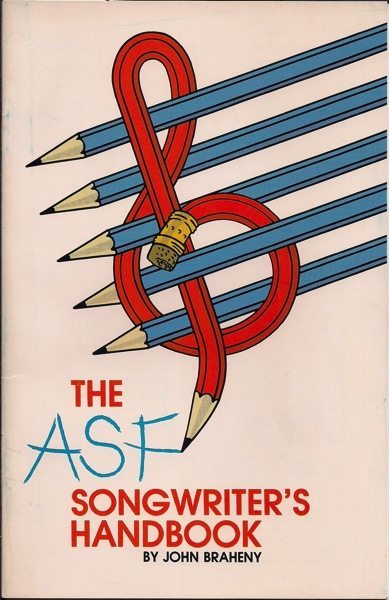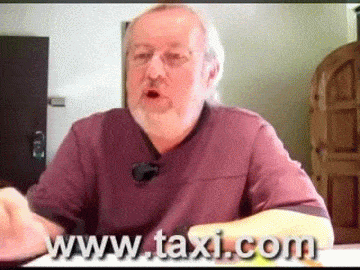A John Braheny Songmine column from the archives…

Accession Number: C000000137-017 Document/Digital File, “Songmine: Scoring Films on a Low Budget Part 2: Research and Spotting by John Braheny”, OCR converted text under same Accession Number
(Digitally converted text. Some errors may occur)
MAY 10-23
Songmine
by John Braheny
Songmine-Film Scoring-Part 2: ‘Research and Spotting by John Braheny
In my last article I talked about the initial preparations for a film I scored, a Ray Bradbury short story called The Flying Machine, set in ancient China. I also spoke about my background and about the prod-ucer/director Bernard Selling. was doing the music with _Curt Berg, an excellent composer, arr-anger and big band leader. Our first move was to see the film, get some general impressions and talk with Bernard about his general concept for the music. Bernard is a musician (something unusual to run into in a director) and he had some ideas. Obviously, the music had to sound Chinese, but he felt it wasn’t important that we adhere strictly to the traditional style. Since, in film scores, basic song forms usually go out the window, except for thematic material, we had some latitude.
Next procedure is to “spot” the film, deciding in what “spots” there should or shouldn’t be music. This is a very subjective procedure. We start by figuring out where the music is absolutely needed to ex-press something that the actors or dialogue can’t say, to heighten the effect of the action, or to give flavor or “color” to a location. We include notes about places for “wild spots” or “stingers” we’ll record just in case we decide later that maybe we’ll need it and save ourselves from a last-minute session. We also decide which music will be out front, and which will be subtle underscoring.
I put together a form for myself that lists, from left to right:Film Footage and Frame Counts; Action; Psychology and Music. We watch the film on a Moviola, an editing machine on which the film, with a dialogue track, can be run back and forth and pieces can be cut or added. It also gives you film footage and frame counts that are mechan-ically geared to the film so that if you start at the same place every time, it’ll continue to be an accurate reference to the beginnings and endings of particular scenes.
Bernard had not completed the editing at this time, so some counts would be different and we’d get the final ones at a later stage. Even though I knew that, I went ahead and mapped out the film scene by scene, which at least would help me remember what followed in the story. Later, we’d convert film feet and frames to seconds to find out how much music we needed. Some Moviolas show time counts as well as film footage. For 16mm film there are 24 frames per second and 40 frames per foot. Under the Action heading I’d write whatever action was taking place in that scene. Under Psychology I’d deter-mine, in discussions with Bernard, the underlying importance of this action. What feeling is he trying to evoke in the audience? Should the music represent the point of view of one of the characters? Should it “tip off” or anticipate the next scene?
For instance, the Emperor is speaking to the “Birdman” in a garden. The Birdman doesn’t know that the Emperor intends to kill him. I needed to know whether Bernard wanted a little “impending doom” undercurrent of music to let the audience know that something was wrong and all was not as friendly as it appeared. He decided he wanted to keep the music light, from the point of view of the Birdman, who thought he might be rewarded for his beautiful invent-ion. That way we, the audience, would identify with him and be be as shocked as he was when the Emperor revealed his intentions.
We discussed the philosophy of the film in terms of the characters. The Birdman, a creator, a dreamer, a free spirit, should be represented by music that soared and evoked a feeling of freedom. The Emperor, bound by tradition and responsibil-ity, should be represented by music that felt more regimented, tight and conservative. After those “psycho-logy” considerations are explored and we have an idea of what the music needs to do, we get to the Music column, where we figure out how to achieve it. We need to consider what instruments to use, tempos, scales and modes, harmon-ies, etc., as well as musicians. To do this we need some information on Chinese music, so Curt called Mr. Lui at UCLA’s Anthromusic Depart-ment, we got together at his house and he graciously demonstrated several Chinese instruments and allowed us to tape his explanations of techinques, tunings and how to write for the instruments. (To be continued.)
Previously in the Songmine Collection:
- Songmine: Scoring Films on a Low Budget Part 1
- Songmine: The Chances for Advances by John Braheny
- Songmine: What a Record Company Needs to Know – Part 6: Attorneys by John Braheny
- Songmine: What a Record Company Needs to Know – Part 5: The Professional Team by John Braheny
- Songmine: What a Record Company Needs to Know – Part 4: What Makes This Act Marketable? by John Braheny
- Songmine: What A Record Company Needs to Know : Part 3
- Songmine: What A Record Company Needs to Know: Part 2 by John Braheny
- Songmine: What A Record Company Needs to Know: Part 1 by John Braheny
- Songmine: Getting the Most from the Trades Part 4
- Songmine: Getting the Most from the Trades Part 3 by John Braheny
- Getting the Most from the Trades
- Songmine: Publishing III
- Songmine: Leave Your Ego at the Door
- Songmine: “Feedback: Why some publishers won’t give it”
- Songmine: Dealing with Rejection by John Braheny
- “Music in Print” – A Songmine Column from Music Connection Magazine March 19-April 1, 1981
About Songmine and Music Connection Magazine:
John Braheny met Eric Bettelli and Michael Dolan right before they were going to publish Music Connection magazine. Eric and Michael wanted to get their publication out to as many songwriters as they could. They had already heard of the LA Songwriters Showcase, and of John and his partner, Len Chandler. John’s goal was to advertise the schedule of guest speakers and performers at the weekly Showcase… so they made a deal.
They published John’s Songmine column (he had never before written a magazine article!) in their very first edition, in November 1977. Trading out the column for advertising, this arrangement continued for many years. Plus, Eric and Michael came to the Showcase each week and distributed free copies to the songwriters!
Those articles became so popular that (book agent and editor) Ronny Schiff offered John’s articles to F&W Media, where they became the backbone of John’s textbook, The Craft and Business of Songwriting. As a follow-up, Dan Kimpel (author, songwriter, teacher), who had also worked at LASS, took on the Songwriting column at Music Connection magazine which continues to this day! You can subscribe to get either hard copies or online.


![Archive Highlight: John Braheny speaks on The Craft and Business of Songwriting [Audio]](http://johnbraheny.com/wp-content/uploads/sites/7/2015/11/jb-M000000102-001.jpg)
